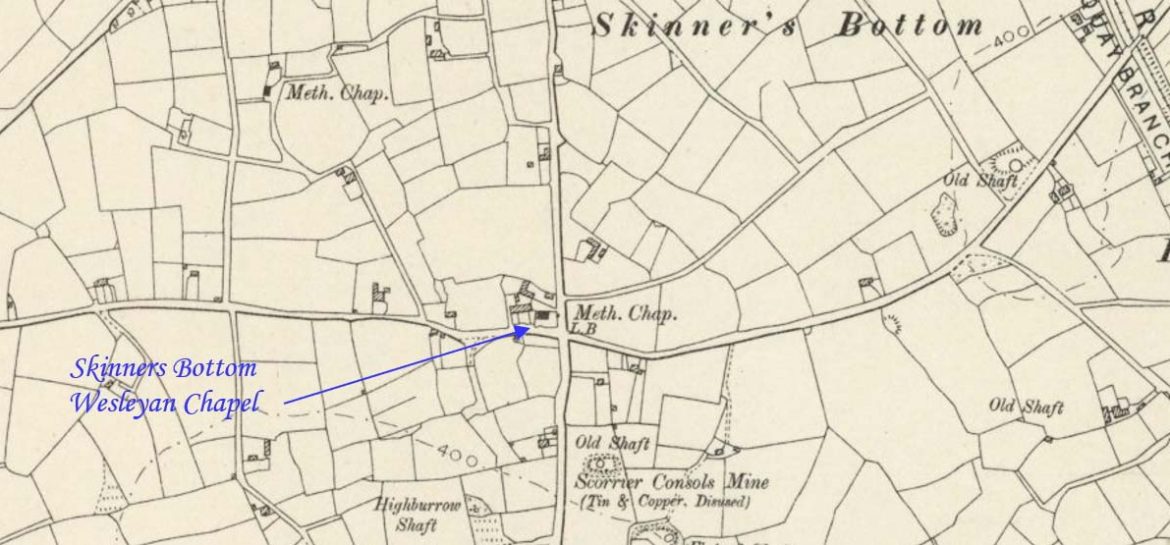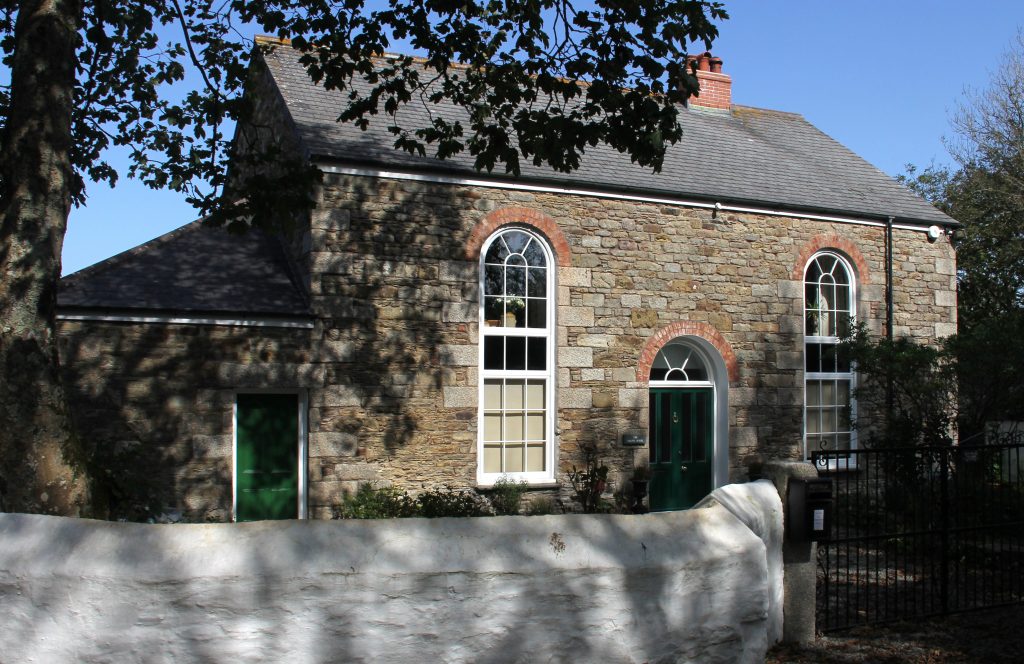
Skinner’s Bottom is a hamlet near Mount Hawke and Porthtowan. This profile of Skinners Bottom Wesleyan Chapel has been compiled by Clive Benney and Tony Mansell.
Earlier Chapel
Unknown Build date.
1860: Skinners Bottom Sunday school formed.
1869/70: A portion of the old chapel at Skinners Bottom was blown down during gale. (Cornubian and Redruth Times – Friday 13 May 1870)
1869 Chapel
 2020: (Photo: Tony Mansell)
2020: (Photo: Tony Mansell)
Skinners Bottom- PERSONS desirous of TENDERING for the ERECTION of CHAPEL at Skinners Bottom, may inspect the plans and specifications, and full information by applying to Capt.
Jenkin, Wheal Rose. No tender will necessarily be accepted. Tenders to be delivered to Capt. Jenkin on or before Monday May 10th, 1869. (Cornubian and Redruth Times – Friday 07 May 1869)
1869: Build date.
Built as a Wesleyan chapel. (SWChurches)
Part of Redruth Wesleyan Circuit. (SWChurches)
Wayside Wesleyan chapel, now converted to domestic use. Killas rubble with granite dressings and brick arches.; dry slate roof replacing original scantle slate roof. Simple Italianate classical example with round-arched openings (window openings deepened); fanlight heads. Wide entrance doorway central to front side wall; round date plaque to 2-window front end wall. Fairly sympathetic conversion. (Cornwall Heritage Gateway)
1870: “Opening a New Wesleyan Chapel at Skinners Bottom. It will be remembered that portion of the old chapel Skinners Bottom was blown down during gale on certain Saturday night last winter, Although the society is small, and nearly all the members are very poor, they determined not to repair the damage, but erect a new and more commodious building. The ‘ways and means’ were speedily forthcoming. Several persons residing at Skinners Bottom and elsewhere kindly subscribed towards the building fund; most of the stones were obtained without cost from the neighbourhood; and a few persons rendered assistance in various ways during the progress of the work. The new chapel was formally opened yesterday week…” (Cornubian and Redruth Times – Friday 13 May 1870)
1888: Certificate of registration, Skinner’s Bottom Wesleyan Chapel, St Agnes. Certificate of registration as place of religious worship. (Kresen Kernow MRR/1394)
1908: The annual tea treat at Skinners Bottom was held on the Saturday before August Bank Holiday (first Monday in August) and a newspaper report in 1908 describes the route. “From the chapel they marched down the hill towards Mount Hawke where the band played at the end of the road. They then turned left to Ivy Chimney where the band played on the triangle of grass (now gone). From here they marched back to Skinners Bottom for the tea treat.”
1911: Skinner’s Bottom Sunday School, which was established in 1860, was holding its tea treat in Will Rowe’s field, opposite the chapel. In later years, this event was a favourite engagement for St Agnes Silver Band when the refreshments were remembered as being particularly delicious.
1932: The Wesleyan, Primitive Methodist and the United Methodist Church amalgamated to become the Methodist Church of Great Britain.
1932: Became Skinner’s Bottom Methodist Church. (SWChurches)
Part of Redruth Methodist Circuit. (SWChurches)
1938: Outside toilets being built but it seems that there were problems and they were not completed until 1942.
1940: Seating for 150. (David Easton, Methodist Minister and historian)
1957: Low attendances prompted a letter to all parishioners seeking their views.
1960: Certificate of registration, marriages, Skinner’s Bottom Methodist Church, St Agnes. (Kresen Kernow MRR/1398)
1975: Closure form signed and its use as a chapel discontinued.
Chattels distributed to other local chapels or sold.
Jul 1976: Plan and elevations, Skinner’s Bottom Methodist Church, St Agnes. Prepared for the trustees prior to sale by Gordon J Pyne, Redruth. With site plan and section. (Kresen Kernow MRR/1977)
1976-1977: Correspondence, sale of Skinner’s Bottom Methodist Church, St Agnes. (Kresen Kernow MRR/1976)
1977 – October: Building sold for £4,500. The chapel minutes state: “After two years of negotiation, “Manchester (Methodist Chapel Committee) delayed things to get the new legislation through to their advantage and the solicitors excelled themselves in dragging their feet.”
